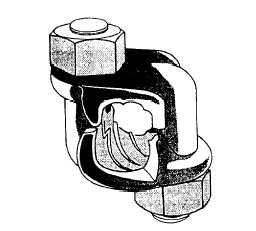| |
Figure 3-33.–Improved type of wire rope clip.
CANVAS
LEARNING OBJECTIVES: Define canvas.
Identify and explain the use and care of canvas
material.
Though canvas is not as prevalent today in a
Seaman's routine as it once was, it is still important.
Canvas, often called duck, is a general name for a
class of strong, heavy plain cloth woven of cotton or
linen. Numbered duck is the canvas encountered most
often, but occasionally you see the term ounce duck or
army duck. Numbered duck runs from No. 1, the
heaviest, to No. 12, the lightest; however, 7, 9, and 11
are no longer issued.
Each number means a certain weight in ounces per
square yard of cloth. For example, No. 1 is 28.71 ounces
per square yard, No. 6 is 20.74 ounces per square yard,
and No. 12 is 11.16 ounces per square yard. Canvas in
weights besides those designated specifically under the
numbered system is called ounce duck. Army ducks are
ounce ducks similar to numbered duck, but have finer
yarns, higher cloth counts, and usually lighter weights.
Canvas usually is made up in bolts and issued by the
linear yard in widths from 22 to 72 inches.
Even with the best of care, canvas is relatively
short-lived, and for this reason, the Navy is turning to
synthetic fabrics. Synthetic fabrics are lighter and easier
to stow and resist rot and mildew. They are also more
durable and less expensive in the long run.
One type of synthetic fabric used extensively for
tarps and awnings and for boat, winch, and reel covers
is a nylon cloth with a vinyl film on both sides. (The
smooth or face side is the side to expose to the weather.)
Two different companies furnish this type of cloth
under their own trade names (Herculite #80 and
Hypalon). These white or grey materials weigh
approximately 19.6 ounces per square yard and come in
50-inch widths. They are fire, water, weather, and
mildew resistant.
Another type of cloth, a black neoprene-coated
material, is less suited for topside uses but has many
below-deck applications, such as for blackout and
welding curtains. This material weighs approximately
2.3 ounces per square yard and comes in a 39-inch
width. Generally, the same care given to synthetic lines
should be given to the synthetic cloths. When synthetic
cloths are dirty, you should wash these fabrics with
saddle soap or any other mild soap and water; scrub
them with a soft bristle brush, using a circular motion;
and rinse them with clear water. In some instances, two
cleanings may be necessary.
Much of the canvas issued in the Navy is treated to
make it resistant to fire, water, weather, and mildew.
Some canvas is waterproof and oil and gasoline
resistant. Current specifications for building ships
require that all topside canvas be treated according to
the intended use. Canvas to be used below decks is
usually white and untreated. Preservatives are available
for shipboard use on untreated canvas or for re-treating
canvas.
New and unused canvas, spare covers, and so forth,
should be stowed in a clean, dry storeroom. Never store
canvas where acid is (or has been) stowed; acid fumes
are detrimental to canvas. Every effort should be made
to provide a space free from rats, mice, and insects. Wet,
painted, or oil-soaked canvas should not be stowed
below decks. Occasionally it is necessary to scrub
canvas that has become particularly dirty or stained by
grease or oil. Use a mild soap solution, rinse thoroughly,
and hang the canvas up to dry.
MEASURING CANVAS
Great care should be taken when measuring and
cutting canvas. MEASURE TWICE AND CUT
ONCE. When measuring canvas for items that will be
stretched taut (awnings, for example), DEDUCT 1/2
inch for each linear foot in both width and length. If the
canvas is to be loose (as for hatch hoods and gun
covers), ADD 1/2 inch for each linear foot in both width
and length. Use the old article for a pattern whenever
possible. When it is not available, make a sketch of the
item, showing all the necessary dimensions, and work
from that.
3-25
|

